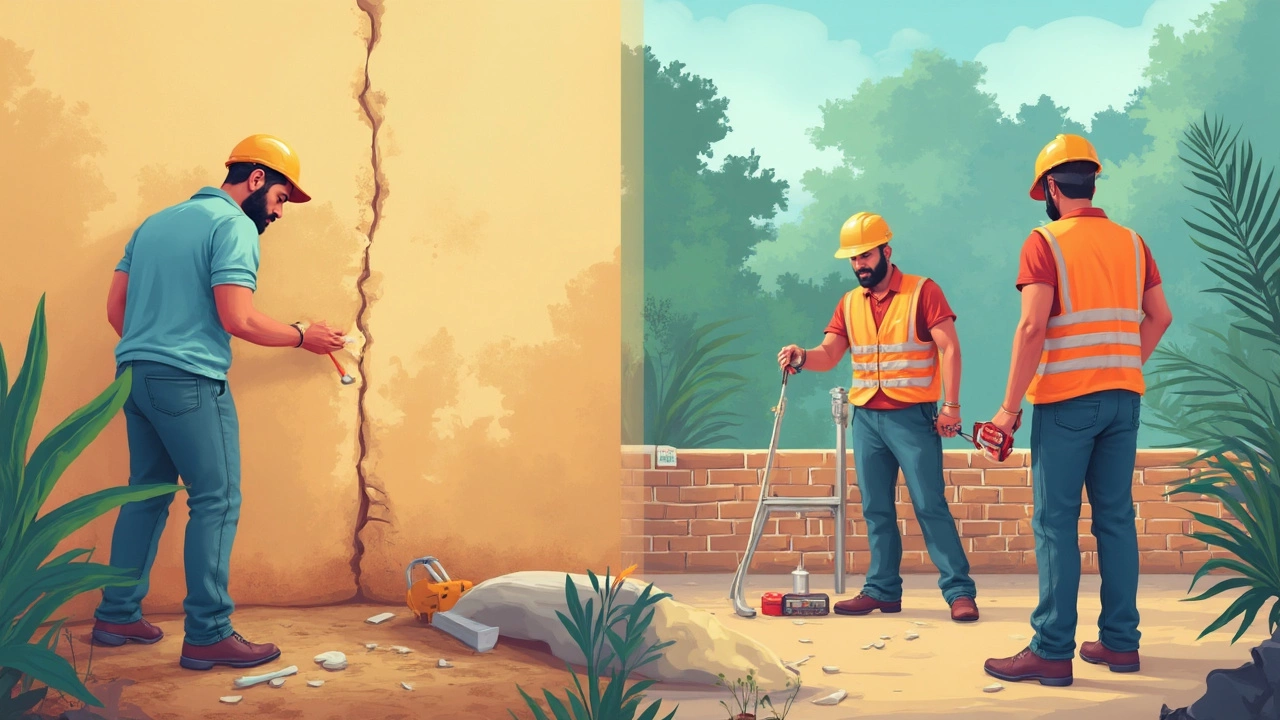Nearly every homeowner dreads hearing, “You’ve got a foundation problem.” It sounds expensive, but even worse—it can mess with your whole house if you choose the wrong fix. Not every crack or sticking door means disaster, but ignoring the signs? That’s how you end up with a tilted porch or jammed-up windows for years.
Some folks think any old sealant or jack will fix things, but foundation repair isn’t one-size-fits-all. One neighbor might swear by mudjacking, while another only trusts steel piers. The truth? The best solution really depends on what’s happening under your house—soil type, water issues, the age of your place, and even the local climate all play a big part. Skip the guesswork: learning what actually works (and when it fails) could save you thousands and a lot of stress.
- How to Spot Real Foundation Trouble
- Popular Methods (and When They Fail)
- What Makes a Repair Method 'The Best'?
- Smart Tips Before You Hire Anyone
How to Spot Real Foundation Trouble
It’s easy to freak out over a crack in the wall, but not all cracks mean serious issues. So, how do you really know when there’s a problem with your foundation repair is needed? Start with the stuff you can actually see and feel every day.
- Cracks in Drywall or Brick: Thin, straight lines under windows or above doors aren’t uncommon in older homes. But if the cracks are wider than a quarter inch, zigzag like a lightning bolt, or get bigger over time—those are red flags.
- Stuck Doors and Windows: If you suddenly need Hulk-strength to open your favorite window or a door scrapes the floor, it could be more than humidity messing with you.
- Uneven Floors: Walk across your house in socks. If you feel dips or notice your marble rolls away for no reason, your floors might be shifting with the foundation.
- Gaps Outside: Walk the outside perimeter. Bigger gaps between bricks, or cracks in your concrete slab, could mean the foundation is moving.
- Bowed Walls or Separation: Interior walls pulling away from the ceiling, or gaps forming where your porch meets the house, signal deeper issues below the surface.
Before you panic, compare your house to others in similar soil. Homes built on expansive clay (common in places like Texas and Oklahoma) get more cracks as the ground swells or shrinks with moisture. Some shifts are just what happens in these areas. Still, catching the signs early stops smaller issues from turning into real headaches or pricey repairs later.
Here’s what foundation problems actually look like in numbers:
| Sign | What’s Normal? | When to Worry |
|---|---|---|
| Wall Cracks | Hairline < 1/8 inch, not growing | > 1/4 inch, growing, diagonal/zigzag |
| Floor Slopes | Less than 1 inch total across 20 feet | 1.5 inches or more across 20 feet |
| Gaps at Windows/Doors | Seasonal sticking, closes with weather changes | Continuous, gets worse over months |
| Brick/Gaps Outside | Small cracks after heavy rain/dry spells | Gaps you can fit a fingertip in |
If you spot several of these symptoms together, snap some photos and start tracking changes. Bring in a pro if you see anything on the “worry” list. Most foundation companies give free assessments, so there’s no harm in double-checking if you’re unsure.
Popular Methods (and When They Fail)
There’s a menu of foundation repair options out there, but don’t assume they’re all created equal—some make sense for certain problems and fall flat on others. Here’s a breakdown of the most common fixes and the real-world situations where they either work like a charm or totally strike out.
- Pier and Beam (or Steel Piering): This is the go-to for serious foundation settling, especially if the soil under your house is shifty. Steel piers get driven deep until they hit solid ground. They’re strong, last for decades, and most pros back them with long warranties. Downside? They’re pricey. Also, if the soil sinks even deeper over time (rare but possible), there might still be minor movement.
- Mudjacking (Slabjacking): Perfect for small sunken slabs, like front steps or garage floors. Contractors pump a cement-like mix under the slab, bringing it level. Fast, cheaper than piers, but not a long-term fix for shifting soils or big, ongoing settlement. If your house keeps sinking, mudjacking won’t keep up—it’s more like a patch than a solution.
- Polyurethane Foam Injection: Like mudjacking, but lighter and less messy. Good for minor leveling jobs and fills little voids. Not strong enough for major problems or homes with heavy clay soil that keeps shifting with the seasons.
- Concrete Pressed Piling: These are concrete cylinders stacked and pressed into the ground by the weight of your house. They work well in places like Texas, where the soil is mostly clay. But in really sandy soils or where’s there’s a lot of moisture, they sometimes don’t get deep enough to be totally stable.
- Sealants and Epoxy Crack Injections: These are the Band-Aids of foundation repair. Sealants and epoxies can close up small cracks to keep water and bugs out, but they don’t fix the root of movement. If your walls are moving, these just hide the problem for a while.
It comes down to this: match the method to the issue. If your home keeps developing new cracks every rainy season, anything surface-level (like sealant or mudjacking) is just a temporary fix. Digging deeper with piers or piles may cost more upfront, but they tackle the real reason your house keeps shifting. Always ask about soil tests and demand a warranty—that’s how you spot a contractor who knows their stuff.

What Makes a Repair Method 'The Best'?
The "best" fix for your foundation boils down to this: does it solve the root problem, last a long time, and keep your house safe—without draining your savings for no reason? People toss around a lot of repair options, but most folks just want one that truly works for their situation. Here’s what makes one method stand out over another.
The soil under your home is boss. If you’re sitting on clay, it moves a lot when wet and dry, so methods like pressed pilings or steel piers handle those shifts better than just filling in cracks. Homes built on sandy ground? Foam injection or concrete underpinning can shine because they stabilize things without heavy digging.
Check out how the main repair methods stack up on the facts:
| Repair Method | Best For | Avg. Lifespan | Estimated Cost (USD) |
|---|---|---|---|
| Steel Piers | Heavy clay, deep movement | 75+ years | $7,000 - $20,000 |
| Drilled Concrete Piers | Newer homes, load-bearing fixes | 50+ years | $10,000 - $30,000 |
| Mudjacking/Slabjacking | Slab homes, smaller issues | 5-10 years | $2,000 - $6,000 |
| Foam Injection | Quick leveling, void fill | 5-15 years | $2,500 - $8,000 |
| Epoxy/Polyurethane Injections | Minor cracks only | 5-10 years | $350 - $1,400 per crack |
Nothing lasts forever, but steel piers and drilled concrete piers usually deliver the strongest, longest-lasting fixes. Still, they aren’t overkill for every home. For smaller cracks in a dry climate, a solid epoxy injection might be all you need to stop water or pests. If your house keeps sinking every time it rains, that’s a sign you need a deeper fix, even though it costs more up front.
So what should you look for? Here’s a checklist to help figure out what’s best for foundation repair at your place:
- Does the method match your soil and house style?
- Is the fix supposed to last at least as long as you’ll own the house?
- Has it worked for homes like yours in your city (ask for local references)?
- Can the contractor back it with a strong warranty (not just a few years)?
- Does the price make sense compared to the risk of the problem getting worse?
Bottom line: The “best” repair keeps your house stable for the long haul, matches your actual foundation trouble, and doesn’t promise quick fixes where a deep fix is really needed. Always get a second professional opinion before spending big—there’s no shame in double-checking when your home’s value is on the line.
Smart Tips Before You Hire Anyone
Picking someone for foundation repair isn’t like calling a guy to mow your lawn. You really have to check their background. Around 25% of homeowners say they’ve run into shoddy work or scams, and with foundation work, that’s money you won’t get back.
First off, don’t be shy about asking for proof of insurance and an actual state license. A legit contractor won’t flinch—if they do, walk away. You also want clear, written estimates. If someone scribbles a number on the back of a business card and gets cagey about details, that’s a big red flag.
Here’s a quick checklist that matters:
- Get at least three separate quotes. This means seeing exactly what’s covered and how the fix compares between companies.
- Look up recent reviews—Google Reviews and the Better Business Bureau are much more useful than random forums. Check if the contractor’s local to your state (not just a fly-by-night crew).
- Ask if they offer warranties that can be transferred to the next homeowner. Many companies give 5-10 year guarantees, but you want it in writing, not just a handshake promise.
- Double check what they actually include—some repairs sound cheap until you realize the price doesn’t cover hauling away dirt, fixing landscaping, or post-job cleanup.
- If someone says permits aren’t needed, that’s usually not true. In most states, big fixes (like installing piers) require city inspection. Always ask about permits.
Worried about the cost? According to HomeAdvisor, the average foundation repair in the US runs from $2,150 to $7,750, depending on the method and location. Pier installation is usually at the high end, small crack sealing lands at the low end.
| Repair Type | Average Cost (USD) | Typical Warranty |
|---|---|---|
| Crack Sealing | $250 - $850 | 1-5 years |
| Mudjacking/Slabjacking | $600 - $1,600 | 2-10 years |
| Pier Installation | $3,500 - $12,000 | 5-25 years |
| Underpinning (helical/piers) | $1,200 - $2,000 per pier | 10-25 years |
One last tip: don’t pay full price up front. A 10-20% deposit is fine. Only hand over final payment after you’ve checked the work and got a sign-off that matches the written contract. Scammers often skip town if paid in full too early—keep a little leverage until everything looks right, and your foundation feels stable again.

Written by Fletcher Abernathy
View all posts by: Fletcher Abernathy